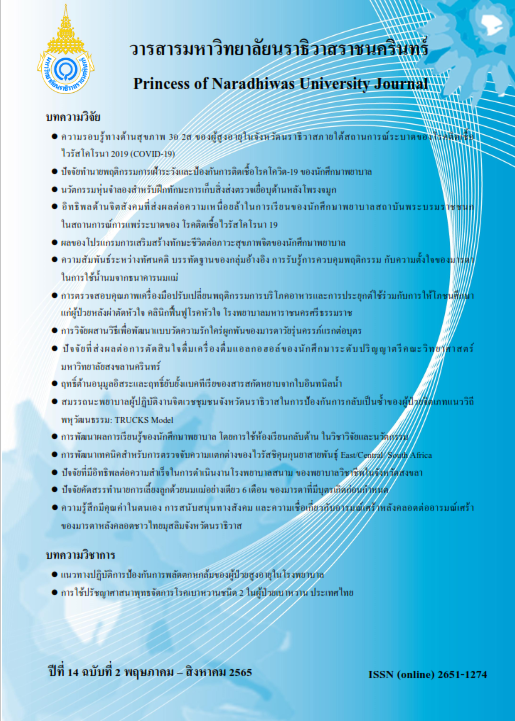Guidelines for Preventing Falls of Elderly Patients in Hospitals
Keywords:
Guideline, Preventing fall, Elderly patient, Tertiary care hospitalAbstract
Falls are a major public health problem. It is the second leading cause of death after road accident injuries. In elderly patients, it was found that there are two risk factors that cause falls, which are internal factors and external factors, the internal factors of a person are physical and mental. Studies have shown that females are more prone to falls than males, because females have less muscle strength than males causing imbalance. As for external factors, it was found that the major risk factors is that the elderly have many common ailments resulting in receiving multiple drugs at the same time may cause various side effects on the nervous system and cardiovascular system, and this can cause the elderly more vulnerable to falls. There were no practical guidelines to prevent such issue. However, the care and surveillance of elderly patients in the hospital is important, to ensure patients’ safety and reduce the loss of patients, families and the overall economy. Therefore, this article aimed to present on fall prevention practices for elderly patients in hospitals which this will be a guideline for caring for elderly patients, for the quality of service and the safety of elderly patients, it is considered the heart of service in Thailand 4.0 era.
References
Alamgir, H., Muazzam, S., & Nasrullah, M. (2012). Unintentional falls mortality among elderly in the United States: time for action. Injury, 43(12), 2065-2071.
American Geriatrics Society/British Geriatrics Society. (2010). Summary of the Updated American Geriatrics Society/British Geriatrics Society Clinical Practice Guideline for Prevention of Falls in Older Persons. Journal of the American Geriatrics Society, 59(1), 148-157.
Assantachai, P. (2015). Health and prevention of falls and complications in the elderly by a geriatric physician. Bangkok: Office of the National Research Council of Thailand. (in Thai)
Bakr. I.M., Abd Elaziz, K.M., Elgaafary, M.M., Kandil, S,K., & Fahim, H.I., (2011). Epidemiologic pattern of falls among inpatients in Ain Shams University Hospital in Cairo, Egypt. Journal of Preventive Medicine and Hygiene, 52(1), 32-37.
Bureau of Epidemiology, Department of Disease Control, Ministry of Public Health. (2015). Control of NCDs. Retrieved May 21, 2010 from http://203.157.15.4/Annual/ANNUAL2550 /Part1/ 6650_Chronic.doc.
Bureau of NCDs, Department of Disease Control, Ministry of Public Health. (2020). Annual Report 2017. Retrieved June 4, 2019. from http://www.thaincd.com/2016/media-detail.php?id= 12986&tid=30&gid=1-015-008.
Chung, H., & Coralic, A. (2016). A multidisciplinary assessment instrument to predict fall risk in hospitalized patients: A prospective matched pair care study. Journal of Nursing Education and Practice, 6(6).
Cohen, L., & Guin, P. (1991). Implementation of a patient fall prevention program. Journal of Neuroscience Nursing, 23(5), 315-319.
George, A.K. & Catherine, E.D. (2009). Urinary Incontinence in the Elderly. American Society of Nephrology, 1-4.
Hendrich, A.L. Bender, P.S. & Nyhuis, A. (2003). Validation of the Hendrich II Fall Risk Model: A large concurrent case/control study of hospitalized patients. Applied Nursing Research. 16(1), 921.
Hignett, S., Sands, G., Youde, J., & Griffiths, P. (2010). Targeting environmental factors to reduce elderly in-patient falls. Loughborough University. Retrieved March 10, 2016 from http:// dspace.Iboro.ac.uk/dspace.
Hospital Accreditation Institute. (2021). Patient and Personnel Safety for Emerging Infectious Diseases. Retrieved March 10, 2016 from https://www.si.mahidol.ac.th/th/division/rm/admin/ download_files/66_40_1JEr PEt.pdf.
Legters, K. (2002). Fear of Falling. Physical Therapy, 82(3), 264-272
Morse, J.M. (1997). Preventing Patient Falls. Thousand Oaks, CA: Sage Publications. National Database of Nursing Quality Indicators. (2013). Changes to NDNQI fall indicator Coming for 2Q 2013. NDNQI Nursing Quality News, 14(1), 2.
Ngamkala, T., Inthasombat, I., & Munkong, S. (2011). Knowledge synthesis. Concerning the revention and management of falls in hospitalized patients. Ramathibodi Hospital, 17(1), 107-124.
Perell, K.L., Nelson, A., Goldman, R.L., Luther, S.L., Prieto-Lewis, N., & Rubenstein, L.Z. (2001). Fall Risk Assessment Measures: An analytic Review. The Journals of Gerontology: Series A, 56(12), 761-766.
Raksri, M. (2019). Effects of Health Belief Adjustment Program on Spill Prevention Behaviors. Fall of an elderly patient in the hospital. Bangkok: Mahidol University. (in Thai)
Scott,V., Votova, K., Scanlan, A., & Close, J. (2007). Multifactorial and functional mobility assessment tools for fall risk among older adults in community, home-support, long-term and acute care settings. Age Ageing, 36(2), 130-139.
Srichang, N., & Kawee, L. (2017). Fall forecast report for the elderly (age 60 years and older) In Thailand, 2017-2021, Bureau of Non-communicable Diseases, Department of Disease Control, Ministry of Public Health. Bangkok: Printing Affairs Office, The War Veterans Organization of Thailand. (in Thai)
World Health Organization. (2021). Violence and Injury Prevention: Falls. Retrieved June 4, 2019 from http://www.who.int/violence_injury_prevention/other_injury/falls/en/
Downloads
Published
How to Cite
Issue
Section
License
Copyright (c) 2022 Princess of Naradhiwas University Journal

This work is licensed under a Creative Commons Attribution-NonCommercial-NoDerivatives 4.0 International License.




